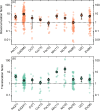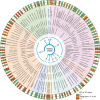Systematic evaluation of plant metals/metalloids accumulation efficiency: a global synthesis of bioaccumulation and translocation factors
- PMID: 40538879
- PMCID: PMC12178126
- DOI: 10.3389/fpls.2025.1602951
Systematic evaluation of plant metals/metalloids accumulation efficiency: a global synthesis of bioaccumulation and translocation factors
Abstract
Phytoremediation, which involves the use of plants to accumulate and translocate metals and metalloids, represents a promising strategy for environmental remediation. The efficiency of phytoremediation is influenced by many factors such as metal/metalloid types, soil properties, and plant traits. It remains unclear how these factors modulate the efficiency of phytoremediation. We synthesized 547 data pairs from 82 studies to comprehensively evaluate the ability of hyperaccumulating plants to accumulate and translocate metals/metalloids under varying environmental conditions. The results show that cadmium (Cd), the most frequently investigated heavy metal, has the highest average bioaccumulation factor (BF) (10.0 ± 1.3) but a relatively low average translocation factor (TF) (1.8 ± 0.1). Aboveground biomass (AGB) of Cd hyperaccumulators is negatively correlated with BF but positively correlated with TF. Cd hyperaccumulating plants exhibit the highest accumulation capacity (maximal BF = 191), with roots outperforming aerial parts. The lower TF is mainly due to the lower AGB of Cd hyperaccumulating plants. In contrast, nickel (Ni) hyperaccumulators exhibit the highest TF, particularly in leaves and stems, indicating that Ni primarily accumulates in the aboveground parts. As soil pH increases, the BF of Cd and Zinc (Zn) decrease, whereas the BF of lead (Pb) increases, likely due to their distinct chemical behaviors under different pH conditions. Threshold concentrations were also identified for several for metals/metalloids (e.g., Cd: 214.8 mg kg-1; Pb: 31352.3 mg kg-1), beyond which BF falls below 1.0, indicating diminished accumulation efficiency due to toxicity constraints. In sum, these findings provide insights for optimizing phytoremediation strategies, aiding in plant selection and remediation condition optimization for improved efficiency and sustainability.
Keywords: bioaccumulation; hyperaccumulator; metals/metalloids; phytoremediation; soils; translocation.
Copyright © 2025 Huang, Zhang, Zhu, Liu, Xiao, Liu and Shao.
Conflict of interest statement
The authors declare that the research was conducted in the absence of any commercial or financial relationships that could be construed as a potential conflict of interest.
Figures









Similar articles
-
Biostimulants efficacy in growing Sonchus oleraceus plants in contaminated mining soil with potentially toxic elements (PTEs).Environ Sci Pollut Res Int. 2025 May;32(25):15374-15387. doi: 10.1007/s11356-025-36577-z. Epub 2025 Jun 9. Environ Sci Pollut Res Int. 2025. PMID: 40488979 Free PMC article.
-
A Phytoremediation Efficiency Assessment of Cadmium (Cd)-Contaminated Soils in the Three Gorges Reservoir Area, China.Plants (Basel). 2025 Jul 16;14(14):2202. doi: 10.3390/plants14142202. Plants (Basel). 2025. PMID: 40733439 Free PMC article.
-
Effects of metal amendment and metalloid supplementation on foliar defences are plant accession-specific in the hyperaccumulator Arabidopsis halleri.Biometals. 2024 Jun;37(3):649-669. doi: 10.1007/s10534-023-00550-5. Epub 2023 Oct 24. Biometals. 2024. PMID: 37874491 Free PMC article.
-
Systemic pharmacological treatments for chronic plaque psoriasis: a network meta-analysis.Cochrane Database Syst Rev. 2021 Apr 19;4(4):CD011535. doi: 10.1002/14651858.CD011535.pub4. Cochrane Database Syst Rev. 2021. Update in: Cochrane Database Syst Rev. 2022 May 23;5:CD011535. doi: 10.1002/14651858.CD011535.pub5. PMID: 33871055 Free PMC article. Updated.
-
Etanercept and efalizumab for the treatment of psoriasis: a systematic review.Health Technol Assess. 2006 Nov;10(46):1-233, i-iv. doi: 10.3310/hta10460. Health Technol Assess. 2006. PMID: 17083854
References
-
- Abdu N., Abdullahi A. A., Abdulkadir A. (2017). Heavy metals and soil microbes. Environ. Chem. Lett. 15, 65–84. doi: 10.1007/s10311-016-0587-x - DOI
-
- Andrés-Colás N., Sancenón V., Rodríguez-Navarro S., Mayo S., Thiele D. J., Ecker J. R., et al. (2006). The Arabidopsis heavy metal P-type ATPase HMA5 interacts with metallochaperones and functions in copper detoxification of roots. Plant J. 45, 225–236. doi: 10.1111/j.1365-313X.2005.02601.x - DOI - PubMed
-
- Anjitha K. S., Sameena P. P., Puthur J. T. (2021). Functional aspects of plant secondary metabolites in metal stress tolerance and their importance in pharmacology. Plant Stress 2, 100038. doi: 10.1016/j.stress.2021.100038 - DOI
Publication types
LinkOut - more resources
Full Text Sources
Research Materials
Miscellaneous

